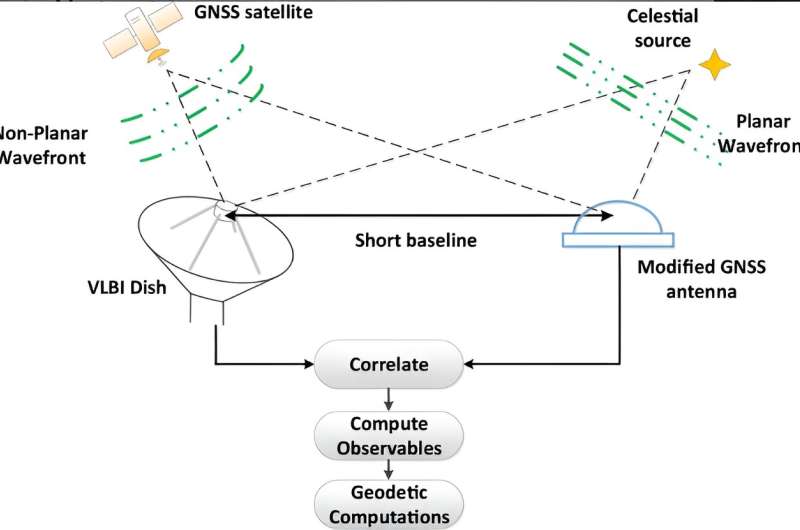
A new scientific technique could significantly improve the reference frames that millions of people rely upon each day when using GPS navigation services, according to a recently published article in Radio Science.
For the first time, researchers at The University of Texas at Austin’s Applied Research Laboratories and NASA’s Goddard Space Flight Center have formed a radio interferometer between a GPS antenna and receiver and a large radio telescope. The new technique leverages a type of radio interferometer, a device that measures the difference in arrival time of radio waves emitted by distant astronomical sources, with antennas that detect and record the emission.
The team used an approach called Very Long Baseline Interferometry to use the sensitivity of the radio telescope to increase the GPS receiver’s sensitivity. This additional sensitivity enabled them to extend the reach of the receivers to observe powerful jets of radiation and particles generated by supermassive black holes up to 5 billion light-years away.
The discovery will improve a variety of critical scientific measurements, from tracking small movements of land in earthquake-prone areas to understanding sea level change.
“The ability to reference new sources directly to GPS antennas paves the way for improvements in geodetic reference frames, which underpin modern navigation in applications from smartphones to national security,” said Johnathan York, a research scientist at Applied Research Laboratories. “Improving reference frames to meet the millimeter-level consistencies demanded by a variety of important Earth science applications is critical for taking the next steps in robust precision positioning.”
Using data collected at the Very Long Baseline Array facility in Fort Davis, Texas, and the nearby McDonald Geodetic Observatory, the researchers were able to demonstrate multiple detections of these powerful extragalactic jets. The detections extend the distance of signals referenced to a GPS antenna from satellites found about 20,000 kilometers away to astronomical objects 5 billion light-years from Earth. This distance is equivalent to flying to a GPS satellite and back about 1 quintillion (a 1 followed by 18 zeroes) times, or an increase of 18 orders of magnitude.
“Expanding the reach of a scientific instrument is common—scientists are always trying to push their instruments to the limit—but a leap at 18 orders of magnitude is certainly extraordinary,” said Leonid Petrov, lead scientist for the Space Geodesy Project at NASA Goddard Space Flight Center.
Observations using this novel combination of antennas and receivers will improve the accuracy of geodetic reference frames, which use a large set of locations measured by positioning techniques such as GPS to establish a common coordinate framework.
Future research will explore the connections between GPS positioning and the positioning based on observations of distant astronomical sources carried out by radio telescopes. Unifying these techniques will further help researchers to improve the geodetic reference frames that define how positions are measured in reference to Earth.
More information:
J. Skeens et al, First Observations With a GNSS Antenna to Radio Telescope Interferometer, Radio Science (2023). DOI: 10.1029/2023RS007734
Citation:
New interferometry technique could improve GPS (2023, November 8)
retrieved 14 November 2023
from https://techxplore.com/news/2023-11-interferometry-technique-gps.html
This document is subject to copyright. Apart from any fair dealing for the purpose of private study or research, no
part may be reproduced without the written permission. The content is provided for information purposes only.
Stay connected with us on social media platform for instant update click here to join our Twitter, & Facebook
We are now on Telegram. Click here to join our channel (@TechiUpdate) and stay updated with the latest Technology headlines.
For all the latest Technology News Click Here
For the latest news and updates, follow us on Google News.
